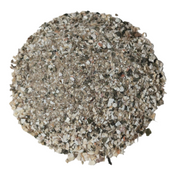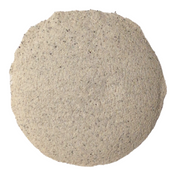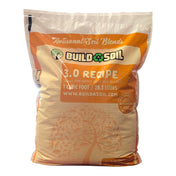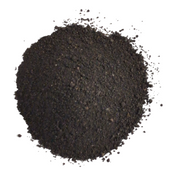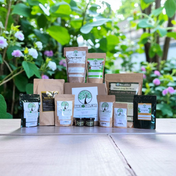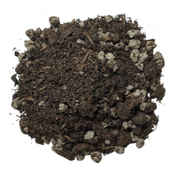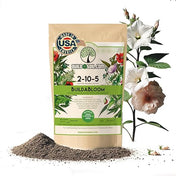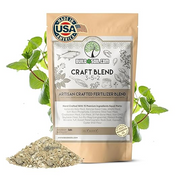its come to my attention that many "organic" soil gardeners are gaining interest in what soil really is and how plants naturally grow..so i thought sharing some detailed information on the rhizosphere & interactions within; would help others possibly gain a better understanding on how to really work with the microbes were aiming to culture, instead of buying into the blindly applying "all in one" inoculate trend..
Rhizosphere: The Inter-Active Root ZoneFrom tiny to huge:
The rhizosphere is the zone of soil influenced by growing plant roots.
Until recently, only the above-ground part of plants has been much studied. "Out of sight, out of mind" is more than an old adage. Science has just begun to grasp the workings of this intimate root zone.
The rhizosphere extends out from the growing root just a few millimeters. It is an incredibly busy soil habitat, and most of its busy-ness is microbial. Within this root zone plants interact chemically with bacteria, fungi, and soil nutrients. Root tips are magnets for life. Bacteria of many kinds assemble in biofilms that surround the root surface. Think of the rhizosphere as an interface between living root and living soil.
The rhizosphere of a particular plant may be small, even microscopic, but consider for a moment how many uncountable billions of trees and forbs penetrate the soil in all the continents of Earth, and consider that no animal life can survive without green plants, and you begin to grasp how centrally important this micro-habitat is to the whole web of ecosystems we call the biosphere.
Here are some graphic introductions to growing root tips.
parts of a root tip and areas of the rhizosphere
graphic from Raina Maier et al, 2000, Environmental Microbiology
Greatly enlarged growing root, showing the multitude of organisms active here
Growing root tip--Root hairs look transparent here.
As the root pushes into soil, tip cells wear off, providing food for microbes
Above, we mentioned "living soil." What lives in soil near plant roots?
- bacteria and archaea
- fungal hyphae (tubes) growing in all directions
- single-celled algae
- protozoans, especially the shelled amoebae
- rotifers
insect larvae, beetles; earthworms, millipedes, snails and slugs
- nematode worms (microscopic)
arthropods such as barely visible springtails and mites;
Relatively enormous animals such as pocket gophers, moles, mice and voles play a role in aerating and loosening soil. Soil is a kind of crucible where organic materials such as leaves are shredded by detritus feeders such as snails, and finally decomposed by fungi and bacteria. The result is humus, source of much of a soil's fertility and its capacity to hold water.
A Gallery of Soil Life:
Micro-life
Incredibly small bacteria and archaea,
2,500,000 in one gram of soil
Frankia filamentous soil bacteria & actinomycetes bacteria give soil its earthy aroma
Micro-Life
Fungi,
400,000 in one gram of soil
fungal hyphae in soil, image credit Tim Wilson, Microbe Organics & bacteria colonizing surface of fungal hyphae
Micro-life
Soil Algae,
two of many kinds of the 50,000 algae in one gram of soil
Chlamydomonas flagellated soil algae; green in life & Chlorokybus soil algae, dividing
Micro-life
amoeba and ciliates,
two kinds of the 30,000 protozoans in one gram of soil
testate or shelled amoeba Arcella image by Wim Van Egmond &soil ciliate protozoans image by Agatha Sabine, U. Salzburg
Middle-sized
life in soil(Meso-Life)
We still can't see them, but they are much larger than above
tardigrade or water bear & nematode roundworm
Macro soil life
visible to the naked eye
globular springtail, barely visible & soil mite, some are barely visible
Macro soil life
highly visible to the naked eye
centipede & millipede
sow bugs, isopod crustaceans & earthworm
Macro-life: tiny but just visible globular springtails feed on a newly emerged mushroom (enlarged)
Image credit John Caddy
Root Exudates
There are many players at the roots. Their interactions are largely chemical. Roots manufacture and exude (give off) a wide variety of compounds that regulate the soil microbial community in their vicinity. Root exudates act as messengers that stimulate the microbial community. Some compounds made by the plant encourage the growth of beneficial bacteria; others weaken and repel harmful bacteria.
One group of compounds exuded from roots are sugars made in the leaves and transferred downward to the rhizosphere to feed bacteria and fungi. These organisms, in turn, act as living fertilizers; they can dissolve phosphates locked in soil and free them so roots can absorb them. Bacteria and fungi also dissolve minerals from rock grains (sand) and make them available. Trichoderma fungi act against attacking fungi as well as activating plant defenses by priming defense genes. Nitogen-fixing bacteria, of course, are well-known symbiotes of roots, providing essential fertilization.
In addition to fungi and bacteria, protozoans play an active role in the rhizosphere. They eat bacteria, and check overgrowth of bacterial populations. Tiny nematode worms are also efficient predators of bacteria. The presence of protozoa in the rhizosphere can increase plant growth. When bacteria are digested by protozoans such as amoebas, more nitrogen becomes available to roots. Nematode digestion has a similar effect. We are just beginning to grasp the incredible complexity of plants' many interactions with microbes in soils.
One set of interactions plants have with other life forms, especially with fungi, are explored in the next section on plant symbiosis.
Symbiosis: Mycorrhiza Plus
Gardeners and farmers have long known that masses of fungus are associated with plant roots, but only recently has the earthwide importance of this association become known.
Some fungi and 95% of plants depend on each other for nourishment. Plants without their fungal partners do not thrive; they barely stay alive.
Observe the two redwood seedlings. The one without mycorrhiza is not a survivor.
Plants evolved from freshwater algae that were already symbiotes of fungi. When land plants left their freshwater origin and colonized land, they carried symbiotic partners with them, on them and inside them. The partners are microscopic fungi.
This mutually beneficial partnership or symbiosis is called mycorrhiza. The word means “fungus-root.” A mass of tiny fungal tubes expands the working area of roots.
These tubes or hypae extend the plants’ reach and makes them strong and growing, by giving them more access to water and necessary minerals. This makes them more resilient against environmental stresses such as drought.
Without mycorhizzal help, few plants can thrive. Without thriving plant life, of course, animal life cannot survive. Mycorrhizza names an earthwide interdependency that is so vast it is hard to comprehend. To thrive, plants—grains, grasses, trees, vegetables—require fungal partners, or symbiotes. Most of these fungal partners cannot even reproduce outside symbiosis. This suggests the antiquity of the association, probably 475-500 million years old. This partnership for mutual benefit is of central importance to the entire biosphere.
The news: fungi are centrally important to the food supply of animals. This means you.
All of the above copied from
Biosphere Kingdom Plants: Rhizosphere, Mycorrhiza, Symbiosis, Defense
An article on Rizosphere and Symbiosis
Jeremy Silva |
















